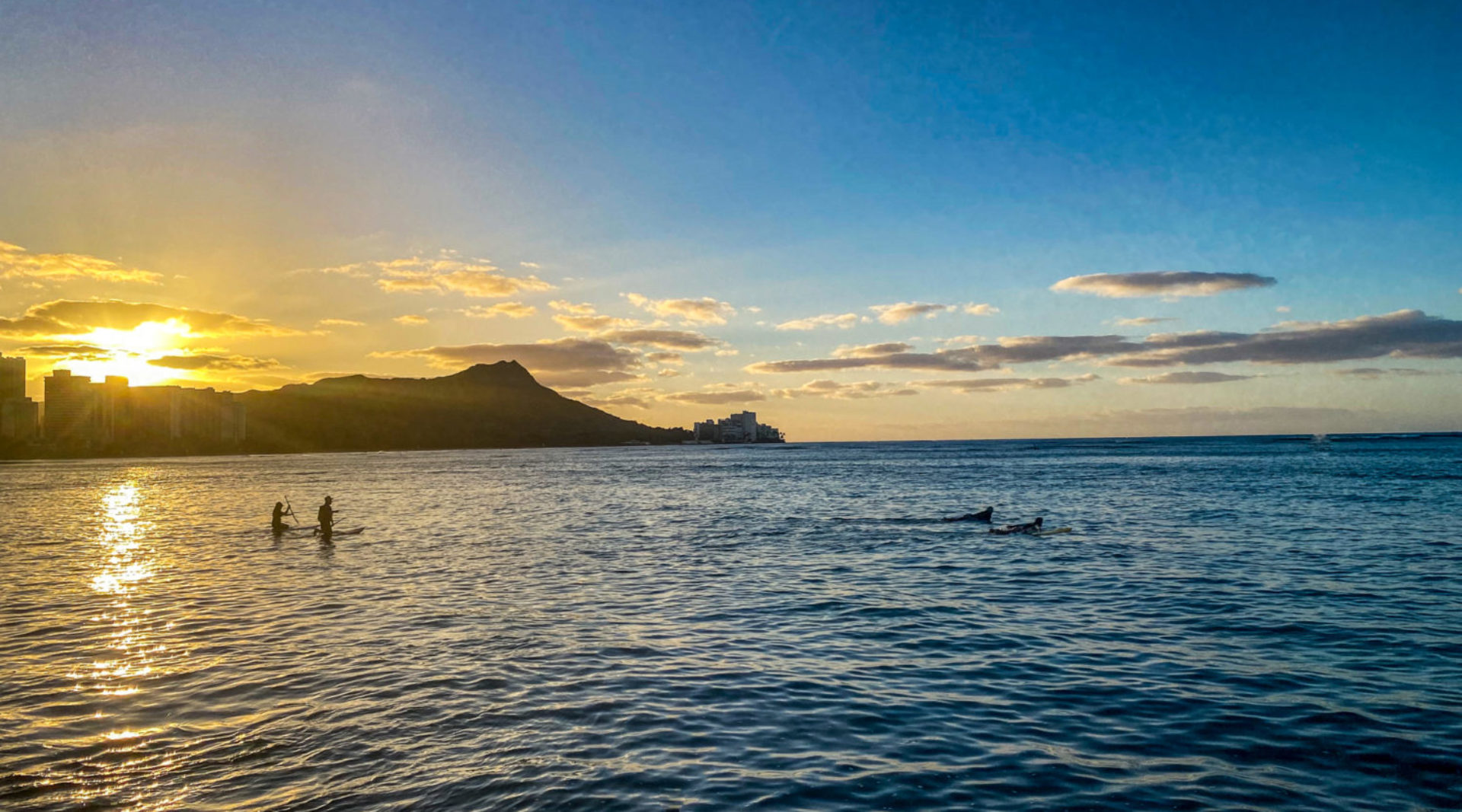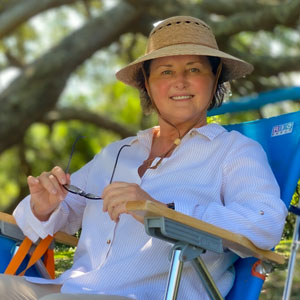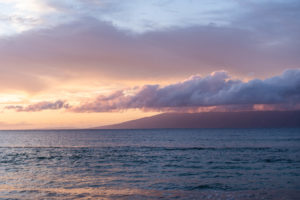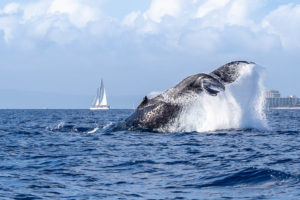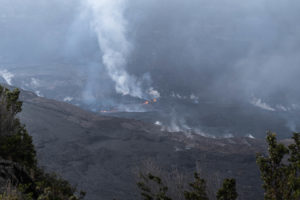Immersion in Hawaiian Culture and History on a visit to Oahu
The verdant Ko’olau mountain range hangs like billowing curtains shrouded in mist, an ethereal image on an overcast day. On the opposite side of the road the turquoise ocean is breaking across hidden coral reefs in the distance, sending wave after wave of white foam gliding to the sandy shore. The enveloping beauty is mesmerizing, visceral, excruciatingly beautiful.

Ko’olau mountains, image by Marie Goff
In January this year my husband, sister, and I set out for Hawaii to escape the cold winter months in South Carolina. Landing on Oahu without an agenda, we scheduled a guided tour and set out in a small excursion van to explore the island. As we traveled North along the shore on the windward (Eastern) side of Oahu, the guide pointed to landmarks along the way. She explained that Hawaiian culture is intrinsically tied to the earth and passed down through generations, is the responsibility to care for the earth, each other, and all living things.

Oahu Shore, image by Marie Goff
“Chapter 5 of Hawai’i Revised Statues “§ 5-7.5 “Aloha Spirit”. (a) “Aloha Spirit” is the coordination of mind and heart within each person. It brings each person to the self. Each person must think and emote good feelings to others.”
The best places to learn about the history and culture of Hawaii and the Hawaiian people are within easy reach of visitors to the Island of Oahu.

Ko’olau mountains, image by Marie Goff
Bishop Museum of Natural and Cultural History
The Bishop Museum offers visitors the chance to journey through the fascinating realms of Hawaii. There’s the realm of the Gods and legends before contact with the Hawaiian Islands; the realm where people live in natural surroundings; and the realm of the noho ali’i, rulers, historical moments, and the connection to the Gods. The Pacific Hall is dedicated to the importance of the ocean in Hawaiian culture and the early Polynesian wayfaring methods. Ancient teachings describe how the sea is connected to the land and the stewardship of these form their connection to people. Ancient healing practices such as Lomi lomi and ho’oponopono and these practices heal not only people but the land, sea, and air.
The largest collection of Polynesian artifacts in the world are located in the Bishop Museum. These include artifacts, heirlooms, and photographs of Hawaii’s ruling families. The rulers of Hawaii believed they descended from the first Polynesian, Papa, short for Papahanaumoku, earth mother goddess. Thus their connection to the earth is spiritual and forms the basis of Hawaiian mythology and religion. These beliefs were transferred through hula dancing, combined with chanting. Hawaiians adorned their bodies with leis (flower, seed, or shell necklaces) and kakau (tattoos). These often identified social status and koa (warrior) skills. Tattoos also serve to protect health and spiritual well being.
For special attractions, plan your visit ahead of time to the Bishop Museum. These may include documentaries such as “We the Voyagers: Lata’s Children”, a documentary depicting “living” Polynesian craftsmen and storytellers.
Iolani Palace
A Registered National Landmark, the Iolani Palace represents the cultural, political, and spiritual heritage of the Hawaiian people. It’s a tangible reminder that Hawaii was once a sovereign nation ruled by a dynasty that lasted 80 years. Hawaii’s royal families lived there and conducted social and political affairs. In 1893, Queen Liliuokalani, was imprisoned on the second floor and it’s there where she signed abdication documents that ended the Hawaiian monarchy. The overthrow of the Queen Liliuokalani and the Kingdom of Hawaii is considered a coup d’état. The end of the monarch saw the establishment of a Provisional Government with thirteen members, foreign residents, who auctioned the furnishing and converted the palace to serve as their official headquarters. This action paved the way for Hawaii to become the 50th State, of the United States. Iolani Palace is the only official royal palace in the United States. Caretakers continue its careful restoration.

Iolani Palace, image by Marie Goff
Statues
Numerous statues in Honolulu honor Hawaii’s heroes. Some of are linked to the beginnings of a royal dynasty and some point to its tragic end. Others are honored for their lasting legacies to the Hawaiian people. These are some of our favorites.
Kamehameha I (1758-1819) There are several statues of Kamehameha I on Oahu. One of these is located at Aliiolani Hale (Hawaii State Supreme Court) across from Iolani Palace. The early years of the founder and first

ruler of the Kingdom of Hawaii is immersed in legend. His birth in 1758 is believed to have coincided with the passing of Haley’s Comet. To the Hawaiians, this was the “light with wings like a bird” that announced a great chief. Later, his destiny was assured by legend, that whoever overturned the Naha Stone weighing between 2.5 and 3.5 tons, would be the first king of all the Hawaiian Islands. Kamehameha I is believed to have overturned the stone at the age of 14. Known as “Kamehameha the Great”, he formed a monarch that lasted for 80 years and was recognized and respected around the world. On holidays, especially June 11, King Kamehameha Day, flower leis drape his outstretched arms all the way to the ground.
Queen Lili’uokalani (1838-1917) is located between the Hall of Columns and the Iolani Palace. Her statue marks the end of the monarchy. She is beloved by the people of Hawaii for her intelligence, poise, and dignity, especially in the face of overpowering forces. Gifted as a musician, she composed the world-famous “Aloha Oe” and more. Many believe that she wrote the book, Hawaii’s Story by Hawaii’s Queen, while she was imprisoned in her palace.
Princess Pauahi – (1831-1884) Princess Pauahi is located in the Grove of the Royal Hawaiian Shopping Center. The last direct descendant of King Kamehameha I, she saw the decline of the Hawaiian population, loss of land, and stripping of language and customs. As a lasting legacy to her people, Princess Pauahi left 375,000 acres of ancestral land, the largest landholdings in the Hawaiian Islands, with instructions to use the assets for educating of the Hawaiian people. The endowment is known as an “enduring act of aloha” and through its holdings has served to educate thousands of Hawaiians in schools K-12 and in communities.
Saint Damien – (1840-1889) Saint Damien’s statue is located at the entrance to the Hawai’i State Capitol in Honolulu. His face bears the marks of Hansen’s disease, a controversial image when first presented. For sixteen years until he died from the disease himself, Father Damien served Hawaiians and others who found themselves isolated on Molokai with the disease. Hansen’s disease was not the only disease that foreigners brought to the Hawaiian Islands. Information differs as to how many Hawaiians died from diseases brought by foreigners but studies show that they may be responsible for 75 to 80 percent of decline of the population. Similar to American Indians, Kanaka Maoli (native Hawaiians) had little or no immunity to the diseases of foreigners.

Saint Damien, image by Marie Goff
“Duke Kahanamoku” – (1890 – 1968) The larger than life image of Duke Kahanamouku reflects his popularity but even in real life his stature was tall at 6 foot 1 inch. He was also known as the “Big Kahuna” (best at his craft). He was a five time Olympic medalist in swimming but is most known for popularizing the ancient Hawaiian art of surfing.
The Polynesian Cultural Center
The cultural practices of Tonga, Tahiti, Samoa, Aotearoa, Fiji, and Hawaii are highlighted by their own unique village presentations at the Polynesian Cultural Center. This is another event to plan in advance; there are eight packages available. No matter what package you choose, the cultural center brings all the history and cultural practices of the Hawaiian people together in a dazzling show, amid lush waterfalls and tropical gardens.
Our Luau Experience
There are other ways to experience a luau. Many hotels around Waikiki offer a luau as an optional experience or the hotel concierge will connect you to one. It’s a fascinating and enjoyable way for the whole family to experience the “spirit of aloha”. A luau is centered around kalua cooking, often pork, and means to cook in the traditional way, in an imu, underground oven.
We attended a luau performed on the lush grounds of our hotel, the Hale Koa. It started at dusk, just when the Hawaiian sky was turning from pale blue to pink, violet, and dark. Females dressed in colorful muumuu’s and males dressed in malo’s (almost a loin cloth but closed like a skirt) greeted us with leis.
Pre-luau activities included traditional cultural activities such as lei making and tattooing with henna.

Musicians played traditional Hawaiian music accompanied by the ukulele or other musical instruments. A performer demonstrated how Hawaiians gathered coconuts long ago by climbing an impossibly tall and slender coconut tree with no assistance. During these activities, the breeze carried the fragrant aroma of kalua pork that had been cooking for hours before our arrival.
At 6:15, a person blowing a conch shell “blowing of Pu” drew our attention to the “pit” ceremony. This started the official luau. As we gathered around the pit, two people hoisted the pork out of a bed of hot coals, stones, and ti leaves using the handles of a wire mesh. They circled the pit with the presentation and entertained the crowd with anecdotes of Hawaiian customs. They explained that leaves from the fragrant ti plant distinguishes kalua pork from other hardwood smoked pork. Vital to ancient Hawaiians, the ti leaves were used for all sorts of things. In addition to adding flavor to food, Hawaiians used them for roof thatching, wrappings for cooking foods, cups, plates, hula skirts, leis, and rain capes.
Performers at a luau are masters of the art of ancestral storytelling through hula dancing and other ancient practices. As we feasted, artisans preformed ancestral Hawaiian hula, Samoan fire dance, Tahitian otea and the Maori haka. The movements of the dancers conveyed the story of their ancestors who voyaged over 2000 miles to reach the Hawaiian Islands. Koa (warrior) demonstrated lua, a fierce traditional style of fighting. The performers bantered with an eager audience as the spirit of aloha imperceptibly embraced the crowd.

Diamond Head from Waikiki Beach, image by Marie Goff
Getting Around Oahu
Waikiki Trolley Hop-On Hop-Off is the best way to travel with offers of a 1, 4, and 7 Day(s) All-Lines Pass. This gets you to Diamond Head, Pearl Harbor, Sea Life Park, Waikiki, Bishop Museum, and more. The drivers are very knowledgeable and friendly, eager to share information about Hawaiian customs and folklore. We noticed our driver using the “hang loose” hand gesture to other drivers. He explained that he was thanking the other driver for letting him maneuver in and out of traffic. The same hand symbol as hang loose is referred to as shaka, and has more than one meaning. It can indicate solidarity, serve as a symbol in greeting, or simply a friendly gesture to say thank you. We rode all six lines of the Waikiki Trolley from the convenient downtown Waikiki hub location. Check for special offers while you’re there. We bought a day pass and got the next day included free.

Motor coach tours with experienced guides takes in a good portion of the Island of Oahu. They are usually out all day and the cost will includes lunch. We set this up with the concierge at the hotel. The concierge is always our first stop after settling into a hotel.
Rental cars are a great way to see the island of Oahu; stop and start at your leisure. It’s best to book rental cars in advance when you book your flight.
Visit the official Oahu tourism site to learn about things to do. Once you’ve studied the options, sit down with the concierge at your hotel. They can explain the options, book your activity, and arrange for travel to and from an event, including tours to other islands.
The Hale Koa Hotel is one place that active military personnel and retirees enjoy Hawaii. It’s located at Waikiki Beach in view of Diamond Head State Monument from the beach out front. Like many hotels, you’ll need to book in advance, as much as a year. Visit here for other places to stay at Waikiki Beach.
Books:
“Moloka’i” by Alan Brennert audio, purchase here
“Hawaii’s Story by Hawaii’s Queen Liliuokalani” purchase here
Magazine:
“Accessing Heritage Wisdom Ancient Teachings Like Lomi Lomi and Ho’oponopono Heal Modern Hurts” Spirituality & Health Mar/Apr 2020
Prior to our visit, we wanted to learn as much as possible about Hawaii, culture, history, and current issues. This YouTube Video examines the controversial issues behind the thought by some Hawaiians concerning sovereignty, the right to govern themselves: Meet the Hawaiians Fighting U.S. Occupation
Music:
Short discussion with Paige Okamura “DJ Mermaid” on Hawaii Public Radio. Excerpts here of four songs from her homeland highlight cultural practices of Hawaii, including the tradition of hula and chanting; “kona”, layers of meaning and metaphor in Hawaiian language; and a sample of beautiful Hawaiian traditional music. Stories for Here & Now filed under Here & Now 09:53 Feb 20, 2020 DJ Sessions: Hawaiian Music From ‘DJ Mermaid’ DJ Paige Okamura shares four songs from her homeland.
Eddie and I invited my Sister, Elaine to join us on this vacation. She was a terrific travel companion. Besides learning about Hawaiian culture and history, we had a great time just being together in Hawaii. Here is Eddie and Elaine on Waikiki Beach. We all especially enjoyed the view and the breakfast at the Hale Koa Hotel.

Sunrise over Diamond Head, image by Marie Goff



